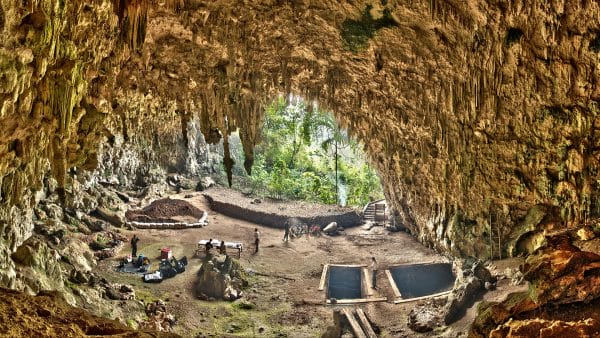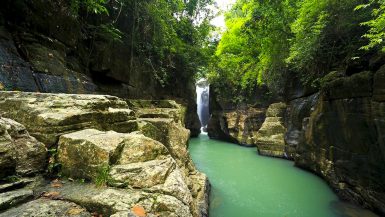In addition to offering a spectacular natural landscape that delights the eye, Labuan Bajo also has hidden gems for fans of history and the notion of human evolution, called Liang Bua Cave.
Since the discovery of seven Homo Floresiensis fossils in 2003, this location has attracted a great deal of interest. The fossils represent a group of early humans with short bodies. These fossils are then generally referred to as “The Hobbit.”
Read on to find out more about this archeological excursion.
Location
Liang Bua is a limestone cave on the Indonesian island of Flores. The cave is located just north of Ruteng in Manggarai Regency, East Nusa Tenggara, but it is situated administratively in Rampasasa, Liang Bua Village. It is around 200 meters from the confluence of two important rivers, the Wae (river) Rancang and the Wae Mulu. This meeting point gives this cave its beauty, with exquisite stalactites and stalagmite decorations that enhance its look.
The civilian communities are familiar with this cave since it is used for various religious rites. The cave is fairly huge, roughly 50 meters long, 40 meters wide, 25 meters tall, and approximately 500 meters above sea level. Further, because its entryway faces northeastern, it was formerly used as a Hobbit’s dwelling.
Route
To get to Liang Bua cave, drive 3-5 hours from Labuan Bajo or around 14 kilometers from Ruteng. You may take Bémo (rural public transit) or trucks. The only way to get there is to walk to the cave entrance. So this is a challenging expedition, and it takes hard work to fully enjoy the mystery feel of this natural scenery.
You may reach Ruteng by the Labuan Bajo, Ende, or Maumere routes. Flight itineraries are offered daily from Kupang to Maumere and Ende. There are additional daily flights from Denpasar to Labuan Bajo and a twice-weekly service from Kupang to Ruteng.
Amenities
You must spend around 20,000 IDR to explore this archeological site. Meanwhile, to avoid getting lost, hiring a guide to assist you and protect you during the tour is best. Furthermore, the site has not yet been heavily exploited by humans; thus, everything is still natural. There are no hotel options nearby for this historical nature visit.
When to Visit
This tour is accessible all year, so you may go anytime you like. However, due to the complex and steep terrain, it’s best to avoid visiting during the rainy season. The wet season will make it more difficult to reach the cave’s mouth.
How to Get there
You can take the Kupang track if you wish to explore the natural beauty of the Liang Bua cave firsthand. Take an aircraft from Kupang to Ende, which takes around 90 minutes. You may also use public transportation to get to Ruteng for around 4 hours on your next trip.
You may continue your journey from Ruteng by transferring by public transit to Rampasasa, 14 kilometers away. The path itself is rather intense and small, with only one car passing, and it is loaded with twisting and steep trails, making this journey quite long and energy-consuming.
The Attractions
According to the facts provided above, this nature tourism is not ideal for everyone. It is only for people interested in ancient sites and the history of human civilization. Nonetheless, during the Anugerah Pesona Indonesia (API) Awards event in Labuan Bajo in 2020, this location was chosen as Indonesia’s oldest and most popular historical tourist destination.
Please keep in mind that this ancient dwelling site has existed thousands, if not 15 million, years ago. However, since the 1930s, local archeologists and archeologists from other nations have been interested in exploring this site.
Many worldwide research institutes were involved in the excavation and study process, including a partnership with Australia’s University of New England and Wollongong.
Next, within the cave, which has been rebuilt after some time has been explored and examined, there is a little museum holding replicas of the fossils discovered and bits of documentation of the excavation process.
To sum up, if you are attracted to historical landmarks, the Liang Bua Cave is a natural attraction that you should see. A worthwhile sight to find out if you want to observe how old life used to be in the area.




